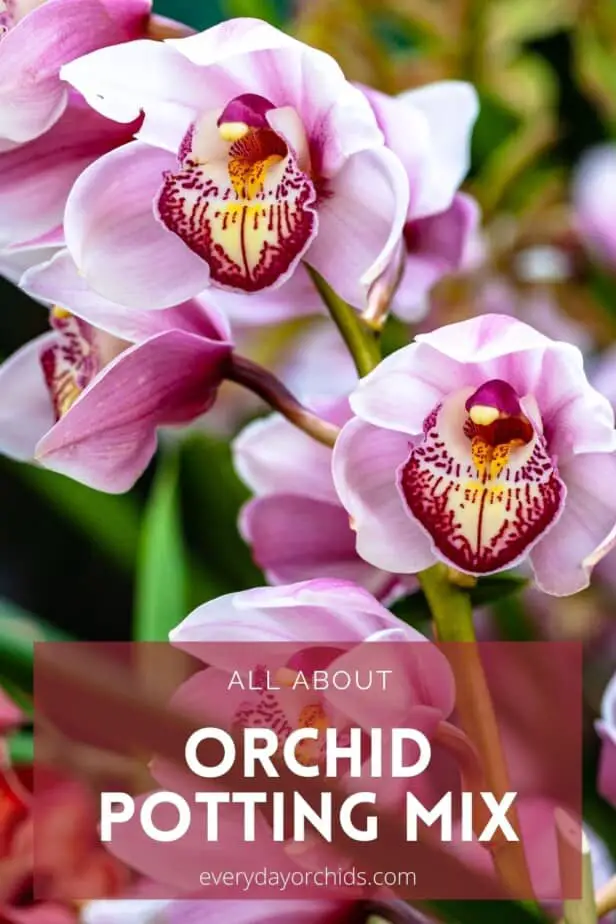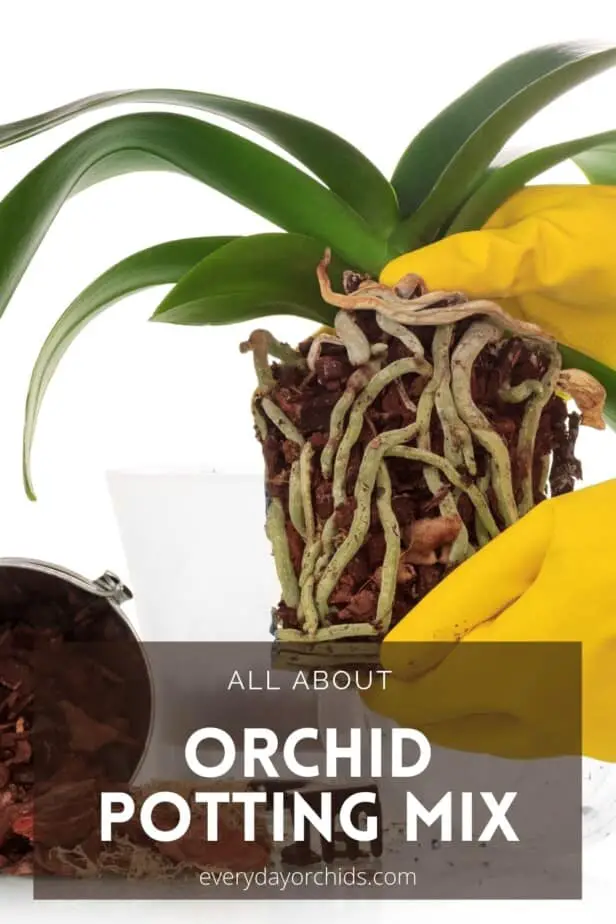When caring for our orchids, we focus a lot on the health of the actual plant. We inspect the leaves and roots and admire the blooms. We think about sunlight and watering and air circulation, trying to provide the best environment for our growing plant. One thing that is often not considered regularly is the potting medium. This is unsurprising, as we typically only focus on the potting media when we need to repot or when something is wrong with the roots. When it is time to change the orchid potting media though, how do we know what makes a good potting media? In fact, what is orchid potting media made of and why is it so special?
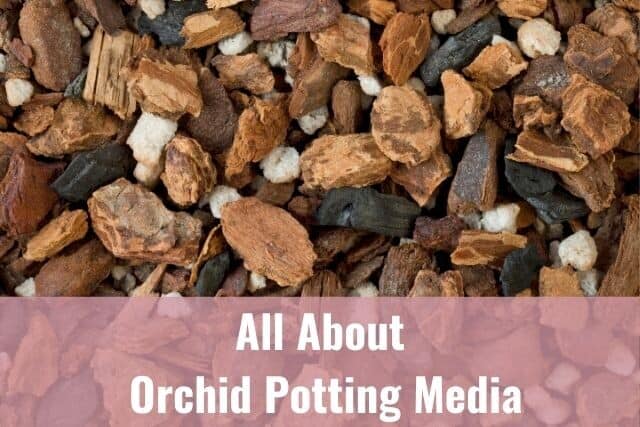
Orchid potting mix, or media, typically consists of pieces of bark, moss, perlite, charcoal, tree fiber, or coconut fiber. The potting media contents will vary according to the manufacturer. In general, medium-grade potting media that will allow for air circulation and root drainage is best for most epiphyte orchids. Some potting mixes also include fertilizer or slow-release plant food that will provide additional nutrients for your orchid.
To answer the questions above, I will go over some key points about orchid potting media. I will also address why using the right orchid potting media is so important for your orchid’s health. Just be aware that I’ll use the terms “orchid potting mix” and “orchid potting media” interchangeably. However, know that they are the same thing. I’ll also give you some tips on how to select a potting medium that is right for your plant. Keep reading to learn more!
Please note that these links are affiliate links and as an Amazon Associate, I earn from qualifying purchases. Purchases made through affiliate links in this post may generate commissions at no additional cost to you. Use this link for a discounted Amazon Prime trial. Thank you for your support!
Table of Contents
Why is Orchid Potting Media Important?

Unlike many other household plants, orchids have their unique needs and challenges. One big difference orchids have from many other plants is their roots.
Before I delve into potting media for orchids, it is important to understand how orchid roots are structured. This will help you understand why orchid-specific potting media is so important to your orchid’s health.
The majority of orchids are epiphytes and their roots are surrounded by velamen. Velamen is a protective coating that acts like a sponge. This allows the roots to absorb and store water and send water and nutrients to the rest of the orchid.
In the wild, epiphyte orchids grow on trees or rocks, and their roots are aerial. The velamen helps the orchid roots to absorb water and nutrients from the surrounding environment.
Air circulation is essential to the health of the orchid’s roots. Constant exposure to moisture over time will damage the velamen. Once the velamen is damaged, the root can no longer absorb or transport water and nutrients. If too many roots are damaged, the orchid will die.
Terrestrial vs. Epiphyte Orchids
Terrestrial orchids can tolerate moisture better than epiphyte orchids. Thus, terrestrial orchids can be planted in loamy soil or fine-grade potting media. For this reason, it is important to know what kind of orchid you have. This way, you can choose the potting media that is right for your orchid.
Planting an epiphyte orchid in regular potting soil would suffocate the roots and cause the orchid to die. Not only will the orchid roots not have enough air circulation, but the constant moisture and density of the regular potting soil surrounding the velamen would quickly destroy the roots.
It is because of these reasons that epiphyte orchids must be planted in an orchid-specific potting media. This will ensure the health and well-being of the plant.
What is Orchid Potting Media Made Of?
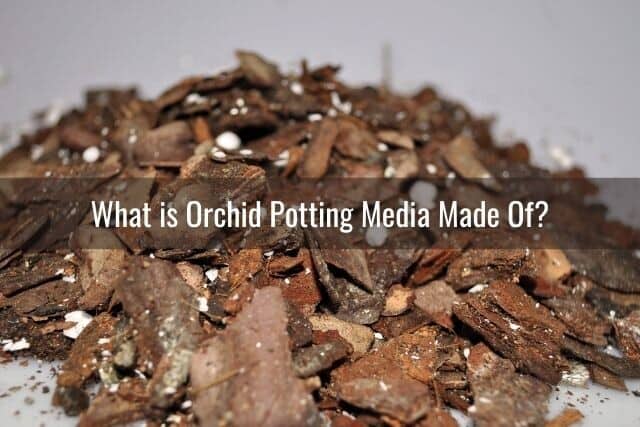
You may be wondering what makes orchid potting media so special and well-suited for orchid roots. Well, let’s discuss that!
Orchid potting mix is designed to allow for good air circulation and drainage around the orchid roots. It is typically made of a mixture of coarse material that is light-weight and airy. Orchid-specific potting media provides spaces and gaps around the roots while not weighing them down.
Most orchid potting media consists of a mixture of bark, tree fern, moss, and perlite. Some mixtures also contain charcoal, lava rock, osmunda fiber or coconut husk fibers. I’ll go into more detail about each specific component below. You’ll get some ideas on how you can choose an orchid potting media that will meet your orchid’s specific needs.
Bark
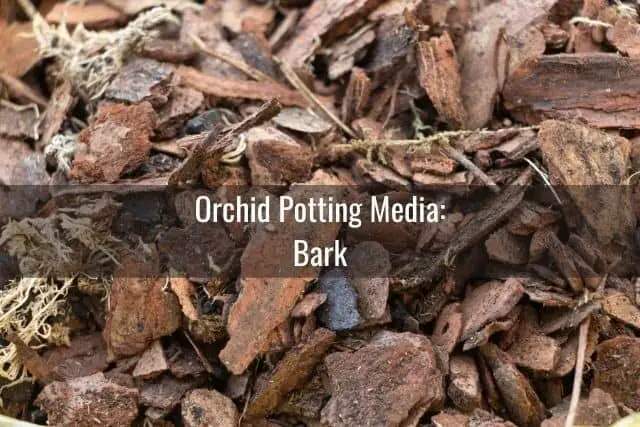
Tree bark makes up the majority of an orchid potting mix. Its purpose is to maximize air circulation around the roots. The type of bark may vary, as some companies use fir bark, while others use pine bark.
Fir bark is a solid choice, as it is fairly water resistant, and a hard wood. Pine bark is more commonly seen in orchid potting media, but it is less desirable. This is because it is a soft wood and less water resistant.
Pine bark is more likely to absorb water than other types of wood. As a result, pine bark will stay moist longer. This will increase the chances for root rot. Pine bark is often found in mulch and is thought of as a “lesser” quality bark for orchid potting media.
A third option would be redwood bark, but this is more difficult to find.
How to Choose The Right Kind of Bark
When shopping for orchid potting mix, you might also notice that there are different grades of bark available.
A fine-grade bark mix will consist of smaller pieces of bark. This is more suitable for young orchid keiki or terrestrial orchids. These types of orchids require more moisture and humidity than most other orchids.
A medium grade bark is found in most orchid potting media. Medium-sized bark pieces will work well for many established orchids and their watering needs. This all-natural organic orchid potting mix by Perfect Plants is a good blend of pine bark, charcoal, sponge rock and coconut chips. It would be suitable for most types of orchids. Sun Bulb also makes a highly-rated orchid potting mix that can be used for Phalaenopsis, Dendrobium, Cymbidium, Oncidium, and Cattleya orchids.
A coarse grade bark has very large pieces. This is best for orchids which need a quick drying, rapidly draining potting medium. It can also be used for orchids which are planted in large planters. This Miracle Gro coarse blend orchid potting mix is an example of a fast-draining orchid mix.
Preparing for Repotting
When initially repotting your orchid, you will need to soak your potting mix in a bucket of water before using it. This is because the woody bark will initially resist water absorption. Pre-soaking the potting mix will prevent it from being too dry for your orchid.
That said, after you repot your orchid in a new potting mix, the new bark will create a drier environment for your orchid. This is not necessarily a bad thing. A drier environment will allow your orchid to recover from root rot and form new roots.
The bark in orchid potting media tends to decompose slowly. The rate of decomposition really depends on how much you water and fertilize your orchid. More frequent watering and fertilizing will cause the potting media to break down more quickly.
The type of wood will also matter. Pine will likely decompose more quickly than a hard wood such as fir. On average, the potting media will last about 18 to 24 months before you will need to repot your orchid and use fresh new potting media.
Moss
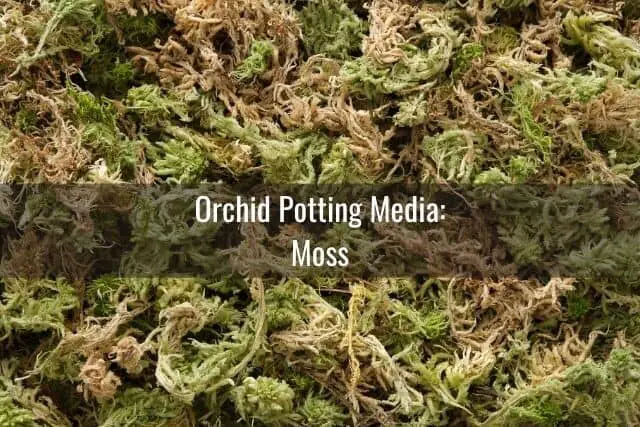
Many orchid potting mixes will contain some sort of moss. This may be a coarse German peat moss or a fine sphagnum moss. Moss is important for its water retentive properties. It helps add moisture and humidity to the potting mix after the orchid is watered.
Moss is lightweight and allows for airflow around the roots. You will find moss scattered throughout the potting mix in pieces or strands.
German peat moss is considered to be superior to sphagnum moss, but is difficult to find. Sphagnum moss is inexpensive and readily available at most garden centers. The drawback is that it has a tendency to clump together. This leads to decreased air circulation in the potting media and over time, root rot.
That said, sphagnum moss does have its benefits. It can be used to regrow roots in an orchid that has lost all its roots. Sphagnum moss can also be used to help grow new keiki orchids.
Coconut fiber
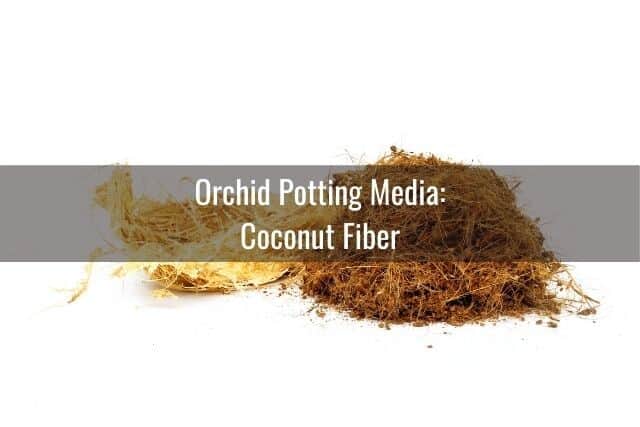
Coconut fiber is sometimes used in place of moss. Much like bark, it is sold in different grades. Fine grade coconut fiber, or coir, looks like hairs or thin roots. Coarse grade coconut fiber comes in chunks and looks similar to tree bark.
Coconut fiber is lightweight and retains moisture well. It degrades slowly and does not have the clumping problems of sphagnum moss.
Perlite
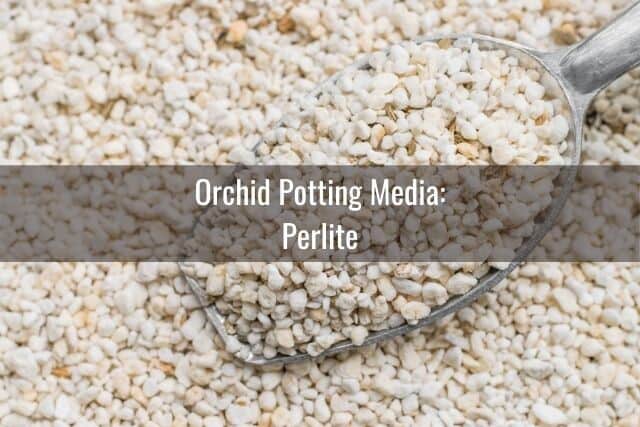
Perlite is a lightweight, white material that looks a little like Styrofoam balls in the potting mix. It is a non-organic additive made from volcanic glass that has been heated. Perlite allows water to drain quickly from the potting media. It also prevents the potting media from compacting and becoming too dense.
In addition, perlite has many tiny air pockets and helps with aeration in the potting media. This porous nature of perlite is important for drainage in the orchid potting mix.
Perlite is used in many soil mixes for the reasons listed above. It is found in orchid potting media, as well as cacti and succulent potting media. It is also found in regular garden soil mixes, though in smaller proportions.
One drawback of perlite is the dust that is created when it is packed with other ingredients. To minimize the dust, soak your potting media before using it. This will help wash away the dust particles.
Tree fern

Tree fern is another component of orchid potting mix. It helps provide aeration and drainage. Much like bark and coconut fibers, tree fern also comes in varying grades, from fine to coarse.
Tree fern looks like little sticks and its shape helps prevent the potting mix from compacting. Tree fern can be found scattered throughout the potting mix, creating air pockets for the orchid roots. It decays at a similar rate to tree bark.
Charcoal

Sometimes you will find pieces of charcoal in your orchid potting media. Charcoal serves to eliminate odors and prevent the build up of bacteria in the potting media. It also makes the potting media less acidic and more basic. A balanced pH level contributes to the orchid’s overall health.
Another thing is, charcoal does not absorb or retain water. This contributes to the drainage of the potting media and helps keep the media dry. In addition, medium to large pieces of charcoal will minimize the compacting of potting media as the media breaks down over time. Unlike bark chips or moss, charcoal does not degrade over time and maintains its shape.
Charcoal is sometimes confused with lava rocks. One difference between charcoal and lava rocks is that salt build-up tends to occur more with lava rocks.
Basically, if you use lava rocks in your orchid potting mix, residual salts from fertilizing and watering will cling to the lava rocks. With charcoal, you will find that the opposite happens. The charcoal actually absorbs the fertilizer salts. This in turn helps protect your orchid roots from root burn due to fertilizer salts.
How Do You Choose a Good Orchid Potting Media?
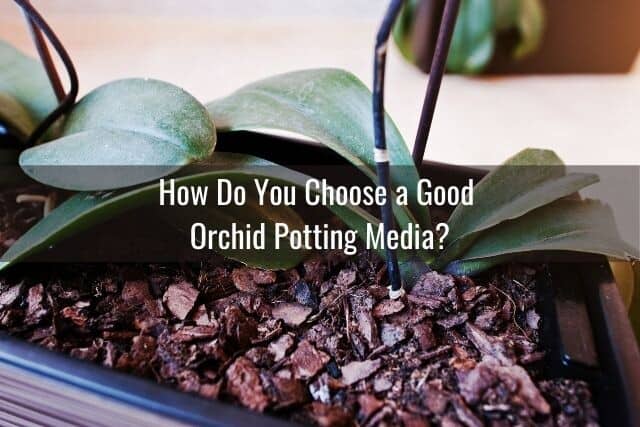
There are a lot of different types of orchid potting media available on the market. Different sellers have created different mixes, each claiming to be the best. So, how do you choose?
First, understand the roles that different pieces of the potting mix play. I talked about this in detail above as I went over the most common orchid potting mix components. By understanding the role of each component, you will know what to look for when buying an orchid potting mix. This way, you can choose a mix that matches your orchid’s specific needs.
Next, I will go over what to look for when choosing an orchid potting mix. You will learn how much to buy and whether or not you need to buy one with fertilizer in it.
The Basics of Choosing Orchid Potting Media
When choosing your orchid potting media, be sure you choose a potting media that has relatively thick, uniform-sized chunks of bark chips. If the bag is clear and you can see the contents, then make sure there are not a lot of small or fine particles, degraded materials, dirt or dust. Those smaller pieces would end up reducing the airflow to your orchid roots. Avoid anything that looks broken down enough to resemble regular potting soil.
Try to choose a potting mix with redwood or fir bark if you can. This type of bark will degrade more slowly over time compared to pine bark.
A one-gallon bag of orchid potting mix should be enough for you to repot several small orchids, 2 or 3 medium-sized orchids, or 1 large orchid.
How to Choose the Right Grade of Potting Mix
If you have a small keiki orchid, terrestrial orchid, or an orchid with small, thin roots, a fine-grade orchid potting mix would be a good fit for your orchid. Finer potting mixes tend to hold more moisture, which is suitable for a keiki orchid. Certain orchids, such as Oncidium orchids, also prefer higher moisture and humidity levels. A fine-grade potting mix would work well for this type of orchid as well.
For most orchids that are older and established, a medium-grade potting mix will be sufficient. Avoid potting media that has a mix of small and large pieces of bark, or broken pieces.
If you are planting your orchid in a large pot or planter and want to ensure good drainage, choose a coarse grade potting mix with bigger chunks of bark. A coarse grade potting mix would also be ideal for orchids that need a quick draining, drier environment.
Should You Buy Potting Media with Fertilizer?
It depends. If you are already in the routine of fertilizing your orchids each time you water them, then no, you do not need to buy a potting media that has fertilizer in it.
Fertilizing orchids that are already planted in a potting media with an extended-release fertilizer can be detrimental to your plants. You might end up with fertilizer burn on the roots or orchids that are over-fed. You might see rapid growth in your orchids due to all the fertilizer, but the rapid growth may also cause the orchids to be weak. They will be unable to fight off disease, pests or deal with stress. What’s more, you may end up with salt residue in the orchid potting media as a result of excess fertilizer salts.
However, if you are the type to forget to fertilize your orchids on a regular basis and prefer to have something “built-in,” then yes, perhaps choosing a potting media with fertilizer might be best for you. An example of this would be the Miracle-Gro Orchid Potting Mix.
This potting media contains enough continuous release Miracle-Gro plant food to feed your orchid for six months after repotting. Once that six months is up, you may opt for a fertilizer like the Miracle Gro Plant Food Spikes. These will take care of feeding your orchids for you for another two months at a time.
What You Should Do Before Using Your Orchid Potting Media
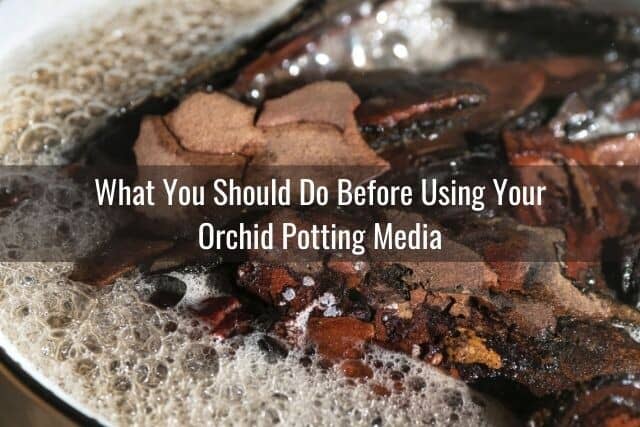
Before you use your orchid potting media, there are a few key things you will need to do. First, inspect your potting media before using it. Look for bugs, mold, or any decaying matter. Smell the potting media. If you smell any mold or rotting fungus smell, throw it away and do not use it. Using potting media that is contaminated with mold or fungus will cause your orchids to become infected as well.
What to Do if You Find Mold or Pests in the Potting Media
Unfortunately, orchid gnats, whiteflies, and other small pests are sometimes found in bags of potting media. Orchid gnats in particular are drawn to damp, decaying media. A sealed bag of potting media with a little bit of moisture trapped inside creates an environment for bugs and mold to thrive. Therefore, it is imperative that you open your bag of potting media all the way. Sift through the contents to check for bugs or other hidden pests before you use the potting media.
If you find mold, fungus, or pests in the potting media, throw it away. That is the safest thing you can do for your orchids. Throw away the bad potting media and buy a new bag. Otherwise you risk infecting your plants by using contaminated media.
How to Kill Pests in the Potting Media
However, if you see just a few bugs and want to try to use the potting media anyway, there is something you can do to salvage it. Some suggest using your freezer to kill any pests hiding in the potting media. To do this, take the following steps:
- Place your bag of orchid potting media in a new, clean garbage bag.
- Place the clean garbage bag with the potting media in the freezer for 2 to 3 days.
- After removing the bag of potting media from the freezer, ensure that the potting media dries out completely. This is to avoid mold or fungus growth.
- Open the bag all the way. Leave it open to allow any moisture or condensation inside the bag to evaporate.
- Preferably, leave the open bag outside in the sunlight to help it dry out before you use it.
- Once the potting media is dry, sift through to check for any living pests, mold or fungus before using it.
Another way to disinfect the potting media is to spray the potting media with hydrogen peroxide. Let it dry before using it.
You can also soak the potting media in boiling water. This is to sterilize it and kill off any pests, mold or fungi. Just make sure you allow the potting media to dry or come to room temperature before you use it for your orchids.
Preparing the Potting Media for Use
Once you have cleared your potting media for use, soak it in a bucket of water before repotting your orchid. Soaking it in water will prevent the new potting media from being too dry.
When repotting, you want to loosely place the potting media around the orchid roots. This will allow for air flow and drainage. Do not pack in the potting media around the roots. You want just enough to stabilize the orchid and its roots. To learn more about how to repot an orchid, check out this guide.
Final Thoughts
Having a clear understanding of why we need orchid-specific potting media is important. In addition, knowing more about each component of an orchid potting mix is key. This will help you choose the right orchid potting mix for your plant. Planting your orchid in the right potting media will help ensure your orchid stays healthy and continues to thrive.
If you enjoyed this article, please pin it and share!
